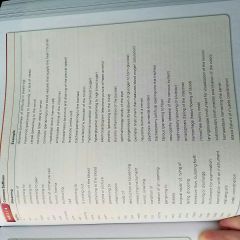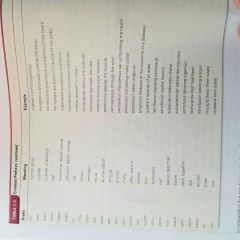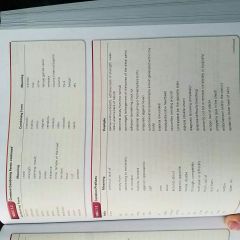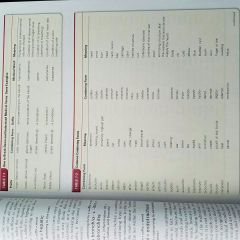![]()
![]()
![]()
Use LEFT and RIGHT arrow keys to navigate between flashcards;
Use UP and DOWN arrow keys to flip the card;
H to show hint;
A reads text to speech;
60 Cards in this Set
- Front
- Back
|
Things necessary for normal cell function |
Oxygen and glucose |
|
|
One fundamental purpose of emergency care |
Maintaining adequate delivery 9f oxygen and glucose |
|
|
Cellular metabolism |
Body breaks down glucose to produce energy |
|
|
By products of aerobic metabolism |
Heat carbon dioxide and water |
|
|
Important cell function that requires atp |
Sodium potassium pump |
|
|
Sodium |
Outside the cell (meaning they were inside before) |
|
|
Potassium |
Inside the cell (meaning they were outside before) |
|
|
Glucose broken down without the presence of oxygen produces |
Pyruvic acid-->lactic acid(harmful to cell/body funtion) and small amount of atp |
|
|
1st stage and 2nd stage of cellular metabolism |
1. Anaerobic---> cytosal 2. Aerobic---> mitochondria |
|
|
Perfusion |
Delivery of oxygen glucose and other nutrients to cells as well as elimination of waste from cells |
|
|
Ambient air percentages |
79% nitrogen 21% oxygen 1% trace amounts of carbon dioxide |
|
|
FiO2 is the fraction of |
Inspired oxygen |
|
|
Carbon monoxide and cyanide disrupts the ability of |
Blood to carry oxygen to the cells |
|
|
Hypoxia |
Lack of oxygen |
|
|
Boyles law |
Volume of a gas is inversely proportional to the pressure |
|
|
Pressure of atmospheric air |
760 mmHg at sea level |
|
|
Prior to inhalation, pressure in chest is |
758 mmHg |
|
|
During exhalation pressure of air is |
761 mmHg in chest |
|
|
Air flows from |
Higher pressure to lower pressure |
|
|
Minute volume |
Tidal volume × frequency of ventilation |
|
|
Average minute volume |
500 ml × 12/ minute= 6000 ml |
|
|
Increase in ventilatory rate can |
Compensate for reduced tidal volume ...to a point |
|
|
Low tidal volume may lead to |
Insufficient volume of air reaching alveoli for gas exchange |
|
|
Dead air space |
Air that doesn't reach alveoli |
|
|
Amount of actually air out of 500 ml that reaches alveoli |
350 ml |
|
|
Chemo receptors both central and peripheral... |
Monitor the pH co2 and o2 levels in arterial blood |
|
|
Central receptors are located |
Near the respiratory center in the medulla |
|
|
Peripheral chemorecpetors are located |
In the aortic arch and the carotid bodies |
|
|
COPD patients have a tendency to retain |
CO2 |
|
|
COPD (chronic obstructive pulmonary disease) patients respiration are controlled by decreased oxygen levels |
Hypoxic drive |
|
|
3 types of receptors in lungs that regulate respiration |
1. Irritant 2.stretch 3. J receptors |
|
|
Irritant receptors |
Found in airways, sensitive to gases and stimulate coughing and bronchoconstriction |
|
|
Stretch receptors |
Found in smooth muscle of airways, protect in inflammation of lungs |
|
|
J receptors |
Found in capillaries surrounding alveoli, they stimulate rapid and shallow ventilation |
|
|
Respiratory control centers in the brain |
Dorsal group--medulla oblongata further input to Ventral on rate and depth Ventral group--medulla oblongata, controls basic pattern of breathing, sends sensory input to spinal chord to stimulate diaphragm and intercontinental muscles Pontine group--sends signals to Ventral to turn off inhalation |
|
|
V/Q rate |
Ventilation and perfusion rate in alveolar capillaries |
|
|
1000 ml of oxygen are delivered to the cells every |
Minute |
|
|
Hemoglobin have ___ iron molecules |
4 and each one can bind to a molecule of oxygen |
|
|
Oxygen bound hemoglobin |
Oxyhemoglobin |
|
|
Non oxygen bound hemoglobin are called |
Deoxyhemoglobin |
|
|
Oxygen is carried through the blood |
98 % Ish bound to hemoglobin 2% Ish in plasma |
|
|
Carbon dioxide is transported in the blood as |
7% In plasma 23 % attached to hemoglobin 70% as bicarbonate |
|
|
Hydrostatic pressure |
Generated by the contraction of the heart and the blood pressure. Exerts a push inside the vessel or capillary |
|
|
Plasma oncotic pressure |
Keeps fluid in the blood vessels |
|
|
CO (cardiac output) |
Heart rate × stroke volume |
|
|
Frank starling law of the heart |
(Rubber band theory) as blood fills the left ventricle, it stretches the muscle fibers, that stretch determines the force available to eject the blood from the ventricle |
|
|
SVR |
SYSTEMIC VASCULAR RESISTANCE |
|
|
Pulse pressure |
Difference between the systolic and diastolic BP |
|
|
Narrow pulse pressure |
(Systolic- diastolic) × 25% |
|
|
3 regulatory influences that control blood flow through capillaries |
Local (temp, hypoxia, acidosis, histamine), neural( sympathetic and parasympathetic NV) and hormonal factors (EPINEPHRINE) |
|
|
Blood pressure = |
CO × SVR |
|
|
Shock |
The insufficient delivery of oxygen and other nutrients to some of the body's cells and inadequate elimination of waste that results from inadequate circulation of blood |
|
|
Preload |
The pressure generated in the left ventricle at the end of diastole |
|
|
Stroke volume |
The volume of blood ejected by the left ventricle with each contraction |
|
|
Blood composition |
🔹45 % formed elements -42to48 percent red blood cells -white blood cells -platelets 🔹55% plasma -91 percent water - plasma proteins...albumin, clotting factor and antibodies |
|
|
Adults have ____ml of blood per kg of body weight |
70 ml |
|
|
Minute volume |
Respiratory rate × tidal volume |
|

|

|
|

|

|
|

|
... |

